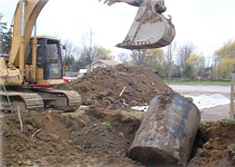 There’s a lot going on underneath our feet that we don’t see. Take, for instance, underground oil tanks. There are more than a million of them buried in the United States, and not all of them are clearly accounted for and/or maintained in great condition. Regulations concerning these tanks didn’t really kick in until the late 1980s, so chances are there are leaking, corroded oil tanks somewhere near you. They’re leaking oil into unprotected soil, and contaminating our collective groundwater. Not good, right?
There’s a lot going on underneath our feet that we don’t see. Take, for instance, underground oil tanks. There are more than a million of them buried in the United States, and not all of them are clearly accounted for and/or maintained in great condition. Regulations concerning these tanks didn’t really kick in until the late 1980s, so chances are there are leaking, corroded oil tanks somewhere near you. They’re leaking oil into unprotected soil, and contaminating our collective groundwater. Not good, right?
This gets especially disconcerting when you consider the what ifs. What if there’s an old tank buried on your property? What if it’s leaking? What if you use well water and some of the oil is mixing in with your water supply? What if you’re getting diseases because of this?
 When oil and its associated chemicals mix with drinking water, it costs a lot of money to clean up. Did you know the EPA estimates all the oil spilled underground could cost $32 billion to clean up properly? Obviously, this is a problem in society, though one most people don’t think about since it’s literally buried. However, if and when it affects you personally, it matters much, much more.
When oil and its associated chemicals mix with drinking water, it costs a lot of money to clean up. Did you know the EPA estimates all the oil spilled underground could cost $32 billion to clean up properly? Obviously, this is a problem in society, though one most people don’t think about since it’s literally buried. However, if and when it affects you personally, it matters much, much more.
Obviously, when you think of underground oil tanks you think, “Well, that’s just for gas stations.” But these tanks are seemingly everywhere, underneath businesses and residential homes. Think about it this way: a long time ago, the area where your home is right now could have been used in a much different way. Decades ago it’s possible that someone, for whatever reason, buried an oil tank underground. Over time, this tank might have been “conveniently” forgotten about. Or, it’s still there and people know it’s there, but “so what?”
Cornerstone Home Inspections of Warren/Bridgewater, New Jersey, does something a lot of inspection companies don’t do: oil tank search, sweep and inspections. If and when you need to know what’s underneath your home or buried in your yard, Cornerstone can find out. Furthermore, Cornerstone can discover if the tank is still sealed or if it’s leaking.
In New Jersey, there are many older homes that were built in a bygone era. A long time ago, many of these homes purposely had underground oil tanks to store heating oil because “that’s how it was done in those days.” However, times changed, and the conversion to gas made the tanks obsolete. In many cases, these tanks were abandoned and/or forgotten. There’s a strong chance you or your neighbor could have a tank on your property.
If you’re sitting atop an old oil tank that’s found to be leaking, it’s going to need to be removed from the property before it can do anymore ecological and environmental damage. This is not a cheap task. It may involve ripping up a driveway, digging up tons of dirt, and tens of thousands of dollars. There’s also the time it takes to accomplish this, as well as the disruption it gives homeowners, who patiently wait for the ordeal to be over and done with.
 Here’s where it gets interesting: buyers don’t want to buy property with underground oil tanks. They see them as a hazard and a risk; in other words, they don’t want the headache of dealing with a leaking underground tank that needs removal to the tune of tens of thousands of dollars. Meanwhile, mortgage lenders don’t want to give money to buyers if they’re going into a transaction involving underground oil tanks.
Here’s where it gets interesting: buyers don’t want to buy property with underground oil tanks. They see them as a hazard and a risk; in other words, they don’t want the headache of dealing with a leaking underground tank that needs removal to the tune of tens of thousands of dollars. Meanwhile, mortgage lenders don’t want to give money to buyers if they’re going into a transaction involving underground oil tanks.
Over the past couple years, more and more people have paid to have their old tanks removed. Indeed, some 3,700 leaking tanks get “remediated” per year in New Jersey. However, it’s estimated that there are some 92,000 underground tanks remaining in the state, especially in older neighborhoods.
Should the tank be old but not leaking, a homeowner will typically pay between $1500 and $2500 to get it out of the ground and gone. If and when there’s a leak, however, that’s where the costs escalate. Removing the tank and cleaning up the soil near it can cost $12,000 to $30,000, and in some rare cases, costs can get as high as $100,000 if the leak is huge and oil has infiltrated the groundwater. Most homeowners’ insurances don’t cover damage done by leaking underground oil tanks. In some cases, people can apply for a grant from the state to help cover the cost of removing a tank.
Keep in mind that tank removal and remediation isn’t just an hour long deal. It typically involves not just weeks but months of clean-up! Therefore, before even thinking of selling a home, a homeowner is wise to have Cornerstone Home Inspections check for any underground tanks on their property. They should also determine if said tanks are leaking or not. If and when a tank is removed, it’s important to save all the paperwork documenting the removal.
By the way, even if an old oil tank was filled with sand or foam, it still should be removed. Even the best tanks can rust, leak and pollute the soil and area groundwater. Most tanks have a “healthy lifespan” of 15 years underground. So, if they’re older than that, chances are there’s a problem underground. That’s why it’s important to have Cornerstone Home Inspections check for such things. Call Cornerstone at 1-800-648-6187 for further information and/or to schedule an appointment today.
